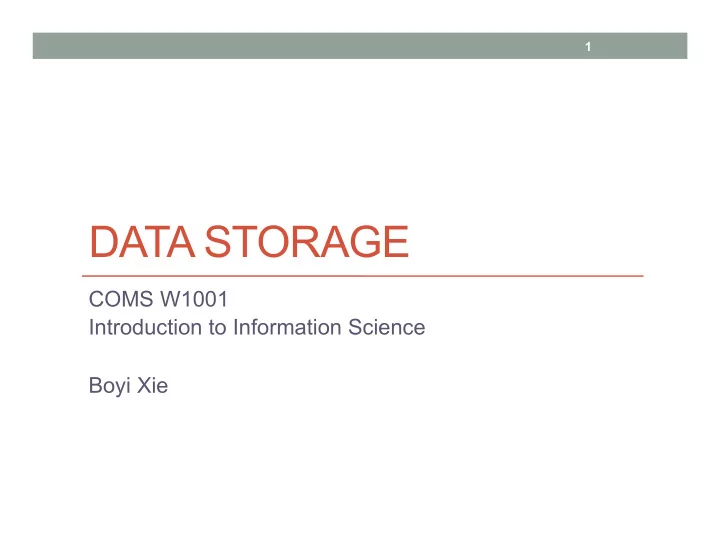

1 DATA STORAGE COMS W1001 Introduction to Information Science Boyi Xie
2 Today’s Topics • Bits and Logic Gates • Bits, Bytes and the Binary System • Binary, Decimal, Octal, Hexadecimal • Representing Numbers • Representing Text
3 Bits and Logic Gates • Bit – binary digits: on/off, true/false, 0/1 • Boolean operation – in honor of mathematician George Boole • AND • OR • NOT • NOT 0 -> 1 • NOT 1 -> 0 • XOR (exclusive or)
4 Bits and Logic Gates • Gate – A device that produces the output of a Boolean operation when given operation’s input value • Electronic circuits in modern computer • Represent digits 0 and 1 using voltage levels
5 Bits and Logic Gates • Flip-flops • A circuit that produces an output value of 0 or 1, which remains constant until a temporary pulse from another circuit causes it to shift to the other value • Consider the following two constructions of flip-flops • As long as both inputs remain 0, the output will not change • Temporarily giving a signal 1 on the upper input will force the output to be 1 • Temporarily giving a signal 1 on the lower input will force the output to be 0
6 Bits and Logic Gates • VLSI – Very large-scale integration • A technology that millions electronic components (e.g. flip-flops) are used inside a computer (on a wafer, or called chip) as a means of recording information that is encoded as patterns of 0s and 1s
7 Bits, Bytes and the Binary System • Byte – 8 bits • Kilobyte (KB) – 1024 bytes (2 10 bytes) • Megabyte (MB) – 1024 KB – 1,048,576 bytes (2 20 bytes) • Gigabyte (GB) – 1024 MB – 1,073,741,824 bytes (2 30 bytes) • Terabyte (TB) – 1024 GB – 1,099,511,627,776 bytes (2 40 bytes) • Petabype (PB) • …
8 The Binary System • A means of representing numeric value (and other information) using only 0 and 1 • Binary Notation
9 The Binary System • Conversion from binary to decimal
10 The Binary System • Conversion from decimal to binary
11 The Binary System • Binary Addition
12 The Binary System • Fractions in Binary • Addition
13 Binary, Decimal, Octal, Hexadecimal • Conversion • Binary to decimal • Decimal to binary • Binary to octal • Binary to Hexadecimal • To convert decimal to octal • First convert decimal to binary • Then make 3-bit a group • To convert decimal to hexadecimal • First convert decimal to binary • Then make 4-bit a group
14 Representing Integers • Two’s Complement Notation
15 Representing Integers • Sign bit – leftmost bit • Complement – 0->1 or 1->0 • Example of negative integer:
16 Representing Integers • Addition • Overflow • positive + positive = negative • negative + negative = positive
17 Representing Integers • Excess Notation • 3 bit pattern – excess 4 notation • 4 bit pattern – excess 8 notation • 5 bit pattern – excess 16 notation • …
18 Representing Fractions • Floating-Point Notation • Decide sign bit • Write down the normalized form • Filled the exponent and mantissa section • Truncation Errors
19 Representing Text • ASCII – American Standard Code for Information Interchange • Use 8 bit per symbol • Unicode • Use 16 bits per symbol
20 References & Photo Credits • Brookshear, J. Glenn (2011-04-13). Computer Science: An Overview (11th Edition). Prentice Hall. Kindle Edition.
Recommend
More recommend